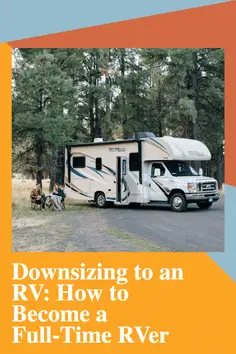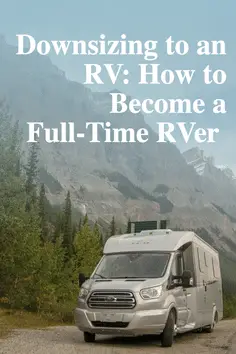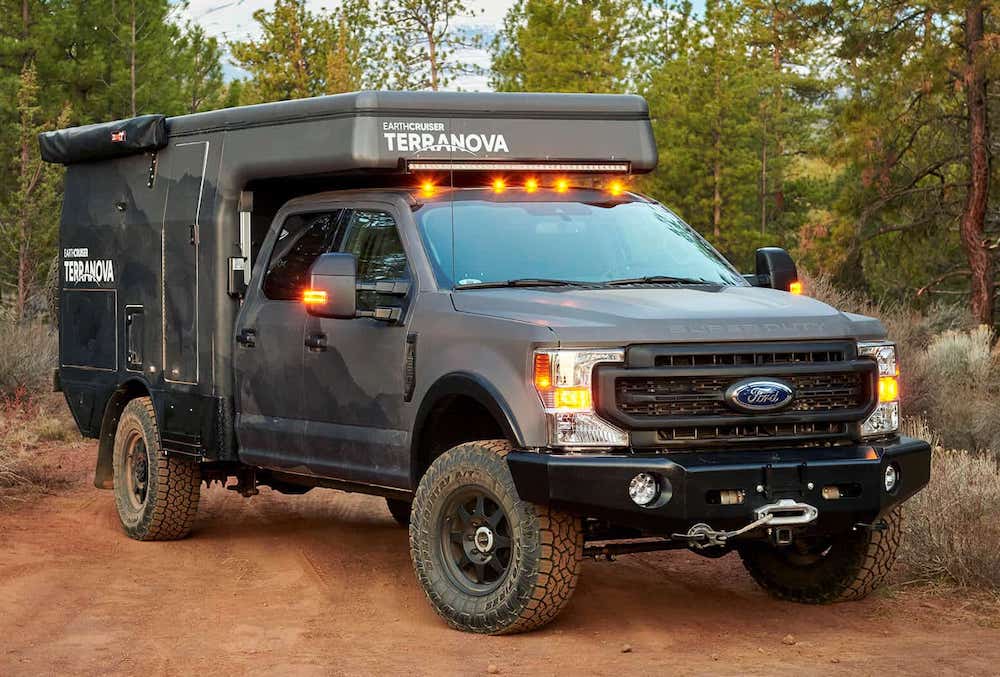Downsizing to an RV: How to Become a Full-Time RVer
This post may contain affiliate links. See our privacy policy for details.
Are you dreaming of living in an RV full-time but worried about whether downsizing to an RV is even possible for you and your family?
Are you wondering what on earth you do with all your stuff?
We can have all the best storage and organization systems in the world, but if we have too much stuff, they won’t be useful.
Downsizing from a house to an RV can seem like a daunting task, but here are some tips to help you in the process.
Downsizing Starts with Decluttering
Without a doubt, any downsizing starts first with a major dose of decluttering. Sorry, but you’re going to have to get rid of a LOT.
The good news is, once you’ve decluttered, you’re about 90% of the way to finishing your downsizing!
We’ve moved country twice now, first time was moving from Australia back to New Zealand, where we took just two large suitcases and two small suitcases with us.
And then 7 years later, moving back to Australia again. Once again, with just a couple of large suitcases.
So we’re reasonably adept at this whole decluttering and downsizing thing now.
I’ve found that for me, downsizing needs to be a process that I go through over at least a few weeks. I don’t like having to downsize in a rush, but that’s just me.
These are my steps to downsizing to an RV:
1. Scan all paperwork
Paperwork is the thing that I seem to accumulate the most of in my life. It’s so annoying, but thankfully, it’s also the easiest thing to declutter.
Step 1: Use a scanner or printer to scan your documents.
I took all those annoying pieces of paper to work (when I was working in an office) and used the big photocopier/scanner/printer to scan all the documents.
It’s so much easier to use a document handler rather than a small scanner, where you have to lift up the lid every time to place a piece of paper down, then turn it over—for hundreds of pieces of paper.
All our invoices, statements, contracts, information products, warranty cards, tax info and everything was scanned and emailed to myself.
Step 2: Rename the files
This step is more annoying than scanning, but also more important.
When the scanned documents are emailed to you, they will have a long and nondescript file name like: IMG938472805827274.jpg.
You must rename your files with an identifying name, or else it will be a complete headache trying to find them later! I use something like: Name_Item_Date.
For example, a scan of the front and back of my Australian drivers license will be:
Michelle_ AU Drivers Licence front_Exp July 2029.jpg
Step 3 (Optional): Upload them to the cloud.
Next, you need to upload your files to the cloud. You could use Dropbox, Google Docs, Evernote, or some other cloud-based storage system. Not only does this make them easy to access from any device, but you’re not limited to keeping them in one physical location like a computer, hard drive, or USB stick.
Step 4: Throw out the original.
Now, you don’t need physical copies of all those invoices, statements, receipts, product disclosure statements, information products, checklists, letters, etc. You’ve got them stored in the cloud if ever you should need them, and you can print out a copy if you must at the time. But you don’t need to find a storage space for all that paperwork anymore.
Except…
Keep the originals of important government documents like birth certificates, marriage certificates, visas, passports, social security cards, etc.
I keep ours in a fireproof bag that I will travel with just in case!
Product currently sold out.
Photos & Cards
Scanning my photos and cards is the one thing that I haven’t got around to doing, primarily because most of my photos are digital.
I have a small box of photos from my childhood and cards from birthdays, like the sweet note my late grandmother wrote me a decade ago.
At the time, I planned to send them to a photo place to be scanned, but it was going to cost a bomb.
So I kept them in their little box in storage.
Yes, I could digitize them to really downsize, but this is one thing that I like holding in my hands!
2. Trash It ♻️
I find that the easiest part of the decluttering process is identifying what needs to be thrown away.
If it’s trash, just throw it out.
Put it in the recycling, if possible, but get it out of your home.
Our society already has such a throw-away mentality so I’m not advocating just throwing everything away, I’m talking about getting the trash out of the way first, so that you can then sort everything else out into whether you’re going to sell, give away or store it.
Trash for me lately has involved:
- Cords that I never use and don’t know what they are for but keep “just in case”
- Documents for products I no longer own
- Magazines I’ll never read
- Games I don’t have all the pieces to
And so on! Identify it, trash it (or recycle or donate as possible!)
3. Stop the flow
For the love…do not buy anything while you’re decluttering. Heck, don’t even buy storage bins! (I just got some for free from our Habitat for Humanity Restore, where people often donate items in bins, and the bins get trashed after they are unloaded.)
Shopping for many of us is a habit. It’s a treat or a pick-me-up or a fun date night activity. But if you’re trying to move into an RV, you may need to stop shopping and kick the mental habit.
Often, we get a little buzz from buying ourselves something. Sometimes it’s to combat boredom and make a day more interesting or exciting.
If you’re changing your lifestyle to RV life, you will not only not have space for more new stuff, you will likely spend your days quite different. You’ll be road-tripping across the mountains instead of heading to your local Target for a fun Saturday morning shopping spree.
When I decluttered, I found so many things that I didn’t need or use that ended up in the trash. Such a waste of money, energy, and (most tragically) our precious natural resources. Not only did I ensure that the item was created in vain, it now takes up space in a dump somewhere.
This process of decluttering and downsizing to an RV has really helped me to stop shopping just for the sake of it and to find other, more constructive, and beneficial ways of making myself feel better about life.
You may find that you need to go through a similar process.
4. Sell
If you can get money by selling the item, then by all means, do that first!
It may require some effort on your part, cleaning it up, fixing it, posting it online, and then organizing delivery. But if it brings in enough money to make it worth all your time and effort, then you may as well. Facebook Marketplace has made this even easier over the last few years.
5. Give Away
I’m more likely to give away my stuff than sell it, simply because I can’t be bothered with all the work involved in selling something (cleaning, fixing, photographing, listing, posting, etc.) when a charity could make some money from it instead.
I figure that if it’s good enough for me to sell, then it’s good enough for me to give to a charity. Find one locally and see what items they will or won’t accept. (Ours won’t take children’s toys, for example.)
6. Store
Storing items should be your last resort if you’re looking to live on the road full-time for a few years.
But if you don’t want to sell everything, you can always store some of your belongings. This is most common for travelers who have sentimental belongings like photo albums, furniture, or an organ from the 1800s that’s been in my family for generations that you simply cannot get rid of. (It’s out of tune, but I still can’t part with it!)
You could rent a commercial storage unit for this, but this can be costly. Alternatively, consider storing smaller items with a family member or in a shed on a friend’s property.

It seems crazy to me to pay for a storage unit, but I can’t judge knowing that organ is in a spare room in my parents’ house!
Keeping some things in storage may be part of your process anyway. When I’ve stored things for a while and come back to sort through them, most things get thrown out.
Sometimes, you need to be separated from your stuff for a while to finally realize that you just don’t need it.
How to Handle Sentimental Items
The absolute hardest part of downsizing to an RV is handling sentimental items like birthday cards, china, a piano, or the couch you spent months saving for.
Figuring out what to do with items that have sentimental value to you is the hardest part of downsizing!
My friend Ashley over at RVinspiration.com has a post on what you should do with sentimental items.
My favorite idea of hers is to give the item to a friend or family member who holds the same sentimental value as you. That way, whenever you visit them, you’ll be able to see the item. Or maybe just knowing that the item is still being treasured in the same way as you did will be enough.
Last Tip: Take your time
My last tip for downsizing to an RV is to take your time.
It’s a process, and it doesn’t have to be done in one weekend. (Unless of course, you’ve left things to the very last minute and now you’re in a mad panic!)
Once we had made the decision to sell up and hit the road, I did two things straight away:
- started by scanning all our documents and storing them in the cloud, and
- did a quick clean out of every cupboard, drawer, and wardrobe in the house (mainly to get rid of all the trash. Why am I keeping measuring cups with broken handles?)
These were the big jobs that could be done straight away and would help with the full clean-up later.
I enjoy the process of going through and cleaning my cabinets, so it’s not something that I would leave until the last week. I find it gives me a sense of control, so cupboards and drawers get cleaned out whenever I have some free time, or more likely, when I am a bit stressed out or grumpy.
If you’ve read Marie Kondo’s The Life-Changing Magic of Tidying Up, you will know that she advises decluttering one area (e.g., your closet) all in one go. The logic is that you deal with the whole thing just once, and you’re not left with piles of clothes all over the place.
You’ll need to figure out what works best for you, your personality, and your circumstances.
Downsizing to An RV
It’s work and it takes time, but the reward is a life well-lived while traveling in your RV.
When we moved into our RV full-time, my husband filled up every cabinet with his things…before I arrived with the pots and pans! He had to cut his load in half while I loaded in the essentials. It may be an ongoing process, but one that’s well worth it.
Next Steps: Organizing your RV
Once you’ve completed downsizing to an RV, you can start thinking about how you want to organize your RV space. You want to make the most of the storage areas that you do have while also making it easy to find the things that you need.
Here are some articles you may find helpful:
- 7 Fantastic Storage Ideas for RV Closets
- 21 Ways to Organize Your RV Kitchen Cabinets & Drawers
- RV & Small Bathroom Storage Ideas
- 4 RV Basement Storage Solutions & Tips
Have you already gone through the process of downsizing to an RV? How did you do it? Do you have any other tips you can share with us? We’d love to hear them!
I love RVing! I share about our journey around Australia, how we came to do this trip, all the planning involved, and snapshots of what life on the road is like.









